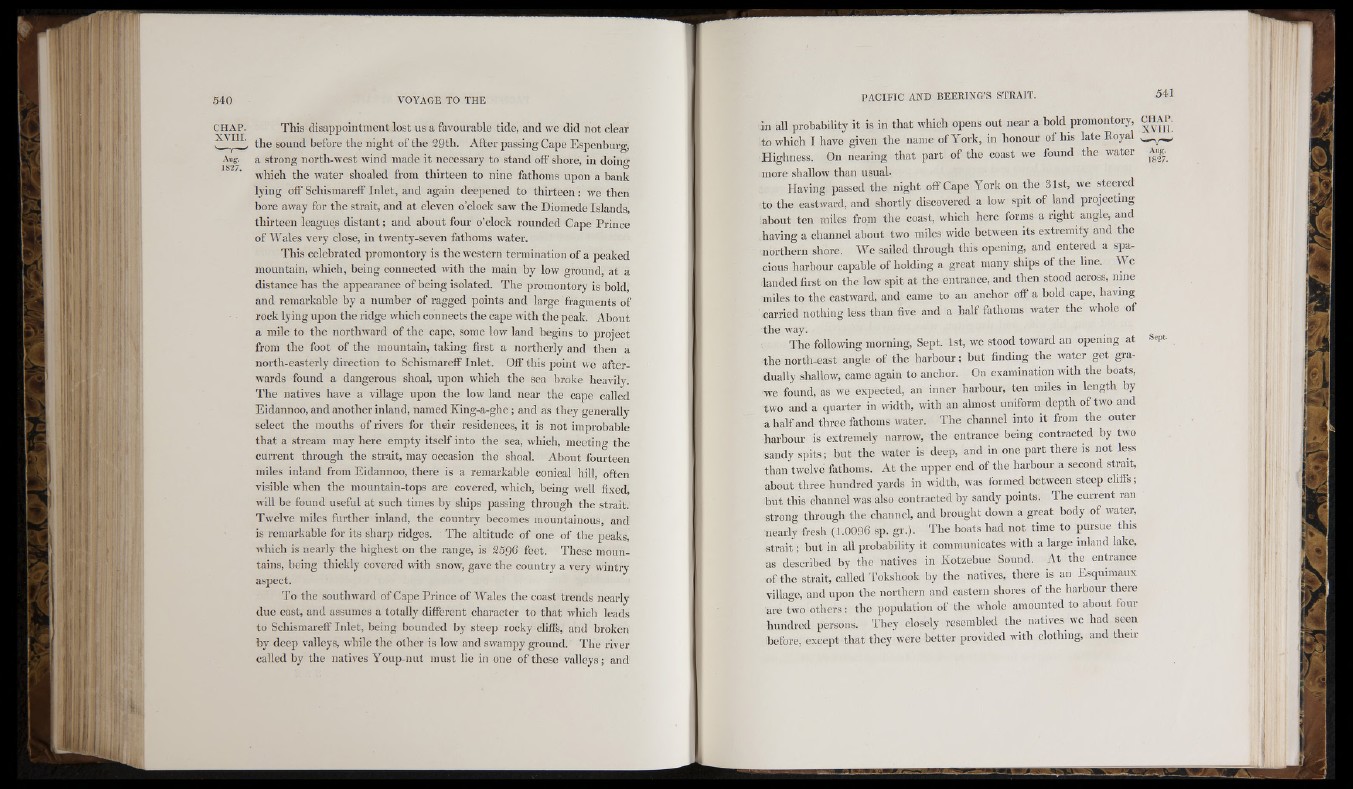
1 *
This disappointment lost us a favourable tide, ,and we did not cleiir
the sound before the night of the 29th. After piissing Cape Espenburg,
a strong north-west wind made it necessary to stand off shore, in doing
which the water shoaled from thirteen to nine fathoms upon a b,ank
lying off Schismareff Inlet, and again deepened to thirteen: we then
bore awjiy for the strait, and at eleven o’clock saw the Diomede Islands,
thirteen leagues distant; and about four o’clock rounded Cape Prince
of Wales very close, in twenty-seven fathoms ivater.
This celebrated promontory is the w'estern termination of a peaked
mountain, w'hich, being connected W ' i t h the main by low ground, at a
distance has the appearance of being isolated. The promontory is bold,
and remarkable by a number of ragged points and large fragments of
rock lying upon the ridge w'hich connects the cape with the peak. About
a mile to the northward of the cape, some low land begins to project
from the foot of the mountain, taking first a northerly and then a
north-easterly direction to Schismareff Inlet. Off this point w e afterwards
found a dangerous shoal, upon which the sea broke heavily.
The natives have a village upon the low land near the cape called
Eidannoo, and another inland, named King-a-ghe ; and as they generally
select the mouths of rivers for their residences, it is not improbable
that a stream may here empty itself into the sea, which, meeting the
current through the strait, may occasion the shoal. About fourteen
miles inland from Eidannoo, there is a remarkable conical hill, often
visible wlien the mountivin-tops are covered, which, being well fixed,
will be found useful at such times by ships passing through the strait.
Twelve miles further inland, the country becomes mountainous, and
is remarkable for its sharp ridges. The altitude of one of the peaks,
which is nearly the highest on the range, is 2506 feet. These mountains,
being thickly covered with snow, gave the country a very wintry
aspect.
’Po the southward of Cape Prince of Wales the coast trends nearly
due east, and .assumes a totally different character to that which leads
to Schismareff Inlet, being bounded by steep rocky cliffs, and broken
by deep valleys, while the other is low and sivampy ground. The river
called by the natives Youp-nut must lie in one of these valleys; and
in all probability it is in that which opens out near a bold promontory,
to which I have given the name of York, in honour o fh is late Koyal
Highness. On nearing that part of the coast we found the water
more shallow than usual.
Having passed the night off Cape York on the Slst, we steered
to the eastward, and shortly discovered a low spit of land projecting
ahout ten miles from the coast, which here forms a right angle, and
having a channel about two miles wide between its extremity aud the
northern shore. We sailed through this opening, and entered a spacious
harbour capable of holding a great many ships of the line. We
landed first on the low spit at the entrance, and then stood across, nine
miles to the eastward, and came to an anchor oft a bold cape, having
carried nothing less than five and a half fathoms water the whole of
the way.
'I'he following morning, Sept. 1st, we stood toward an opening at
the north-east angle of the harbour; but finding the water get graduaUy
shallow, came again to anchor. On examination with the boats,
we found, as we expected, an inner harbour, ten miles in length by
two and a quarter in width, with an almost uniform depth of two and
a half and three fathoms W'ater. The channel into it from the outer
harbour is extremely narrow, the entrance being contracted by two
sandy spits; but the water is deep, and in one part there is not less
than’twelve fathoms. At the upper end of the harbour a second strait,
ahout three hundred yards in width, was formed between steep cliffs;
but this channel was also contracted by sandy points. The current ran
strong through the channel, and brought down a great body of water,
nearly fresh (1.0096 sp. gr.). The boats had not time to pursue this
strait; but iu all probability it communicates with a large inland lake,
as described by the natives in Kotzebue Sound. At the entrance
ofth e strait, called Tokshook by the natives, there is an Esquimaux
village, and upon the northern and eastern shores of the harbour there
are two others: the population of the wliole amounted to about four
hundred persons. They closely resembled the natives we had seen
before, except that they were better provided with clothing, and their
C H A P .
X V I ll.
Aug.
1827.
Sept.